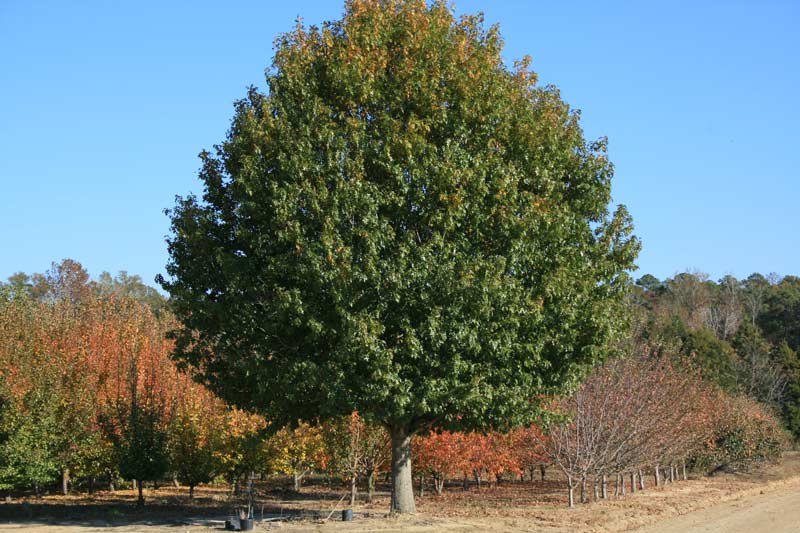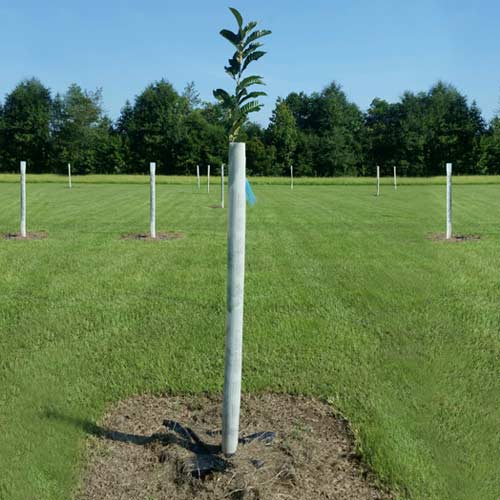
- Location – choosing the site of your trees will decide the type of oak that you can plant. Dry site, wet site, rocky acidic soil, or blackbelt alkaline soil, etc., and sunlight are all critical.
- Layout – After choosing the site deciding on the plant spacing will determine how you intend to care for the trees. If this is a reforestation site, you should plant the trees on 12 x 12 spacing to grow fast and tall, limiting limb structure to produce more towering trunks and shade out competition. But suppose you are looking for a park-like setting with maximum limb structure and acorn production. You will need a 30-50 ft spacing. I would recommend protecting each tree with a 5 ft tree tube, fiberglass stake, and weed mats. Doing this almost guarantees the survivability of each tree.
- The second part of the layout would be to mark each spot for tree placement, which allows you to know exactly how many trees you will need. It also allows you to be prompt with planting and distribution of the trees after you receive them. (Never let the root system dry out or freeze before planting.)
- Planting- Dig holes more significant than you will need. If you are planting seedlings, use a post-hole digger or hand auger to dig a large hole. Be sure to break up the edges, not having a round hole with hard sides. Leaving hard sides will cause the root system to circle as if it were in a plastic pot. Amend the soil only if needed to fill in voids of clumpy soil that will not pack back into the holes sufficiently. Water the tree in well at planting to settle the soil and remove air pockets.
- Planting Dates- The best planting dates, regardless of your location, is October thru March. April is too late, and I don’t care if you are in Ohio, Pennsylvania, Illinois, or Montana. Plant as early as possible before spring. Well, my ground is frozen, and I can’t plant. It’s not frozen this entire time, and if you can work your soil, you can plant trees. The ground generally will not stay frozen for four months, so you can find times to get trees planted. Plant and then mulch the ground heavy to protect the root system.
- Protecting your trees- when planting for reforestation using close spacing, I see no need for plant protection. Plant the seedling close because the strong will survive, and once they mature, you can thin. If planting for orchard typesetting, I would use tree tubes and all accessories. The tubes protect from wildlife eating and rubbing and push the tree to grow three times as fast. Trust me on this; you need to use tree tubes.
- Planting container plants (potted plants) – all of the above info will be the same, except it is imperative to plant anything coming out of a pot slightly higher than ground level. It would be best to protect the trees from bucks with trunk protective tubes or wire cages.
- Do not fertilize the trees for the 1st You may add some Bio-nutrition that contains many organic micro-organisms that will help balance the soil and add a small amount of nitrogen and potassium.
- Lastly, it would be best to put a lot of effort into caring for the trees in the 1st Most individuals will be very excited about the trees early on, and spring will show a lot of promise along with much-needed rain. But inevitably, it will get hot and dry. Usually, this will be in August, September, and October. The trees will need water at that time, especially any potted tree that you may have planted. Watering can be as simple as placing a five-gallon bucket beside the tree with small pinholes drilled into the bottom and fill with water. Adding the small holes will allow for a slow drip from the bucket so that water will soak in and not runoff. Seedling trees planted in tree tubes and weed mats should survive without any added water. Weed mats and mulch will help retain moisture and prevent moisture-sucking weeds from taking over around the tree.
Now that we have moved from the prep and planting let’s look into some of the varieties that would be suitable in different scenarios. Most people will toss around terms like white oak or red oak, but we have at least 90 recognized species of oaks in the United States. The USDA has an excellent field guide for oaks in the eastern U.S., Listing twenty-five of each species with descriptions of each species. I would highly encourage everyone to purchase this book for field reference.
Choosing species of white oaks for planting will vary because of soils. White oaks will grow in both areas, but you must pick the correct varieties for wet or dry soils. For flood-prone areas, you need to plant Swamp Chestnut Oak, Overcup Oak, Swamp White Oak, Bur Oak, and Durand oak. Keep in mind that these trees can take occasional flooding but cannot grow in the water. A listed description would read that these trees would prosper in moist, alluvial, well-drained soils and suitable for lowlands and flood-prone areas. Other white oak species, such as the common White Oak, require an upland site, acidic, well-drained soil. In contrast, the Chinkapin Oak will thrive in calcium-rich high alkaline soils like central Alabama’s blackbelt.
Moving on to the Red oak species, you will find the same scenarios where several species will be prime duck hunting habitat trees. These particular trees can grow in flooded areas and produce smaller acorns easier for ducks to eat. For instance, Nuttall oaks, Pin oaks, Willow oaks, and Water oaks can take standing water during the dormant season, which is December through February. I recommend removing the water if possible before the end of March or earlier. Another thing to remember is that although White oaks are more desirable because of the lower tannins, red oaks will not rot on the ground or germ as quickly as white oaks do. Thus, animals can feed on these much longer in the season and are often viable food well into April/May.
Nuttall Oak(Quercus texana) is one of my favorite oaks. This particular tree is listed as wetland species and thrives in flood-prone areas. It is also the latest dropping acorn tree that I have personally seen in the woods. It will typically produce acorns in 7-10 years and drops them from late December thru February. I have seen some still dropping March, making this tree a fantastic tree for turkeys as well. Little known to most, this same tree is one of the top landscape trees for residential use because of its exceptional growth in full sun. I have gotten many calls from customers who have seen the Nuttall Oak growing in a parking lot and were curious about the species. It’s an excellent tree for late-season acorn production as well as fantastic fall color.
In summation, oak trees sometimes get a bad wrap because they are marked as slow growers and take so long to produce. Some trees do take a while to produce acorns, but some are pretty quick growers and producers. I’m pretty sure everyone has heard of or planted the Sawtooth and Gobbler Sawtooth Oaks. Both are fast growers and produce acorns in 5-8 years when planted on well-drained sites with slightly acidic soils. They have begun to get a bad rap because they are a non-native species.
Not all of our native species take 20 years plus to produce acorns. Many trees will produce acorns within ten years and sooner. For instance, Chinkapin Oak is white oak and typically will start to produce acorns in the same time frame as Sawtooth Oaks 5-8 years. Dwarf Chinkapin oaks will also produce at a very early age of 3-5 years. Live Oaks, believe it or not, are versatile trees that grow in varying soil conditions and bare acorns in the same 5-8 year time frame. It’s a great hunting tree for the Southeast and holds its acorns until late November/December here in Alabama. I have Bur oaks as well as Nuttalls that have bumper crops at ten years of age also. So do not get caught up in all the hype about slow growth and production. Pick a good site and pick matching trees, and put them in the ground. I guarantee you one thing, if you do not plant trees, you will never have acorns nor the shade for yourself or your family to sit.
You can see the true character of a man that plants a tree, knowing that he will never be able to sit in its shade. The best time to plant a tree was yesterday, and the next best time is today.
— Allen Deese



